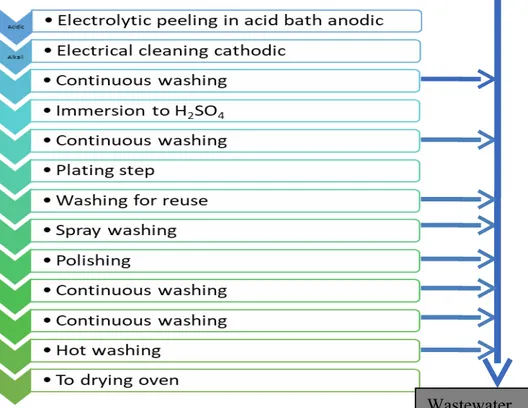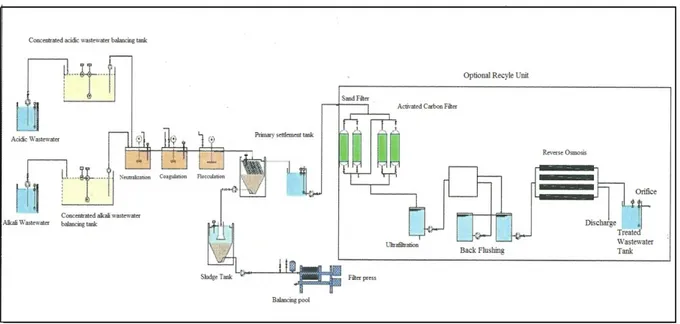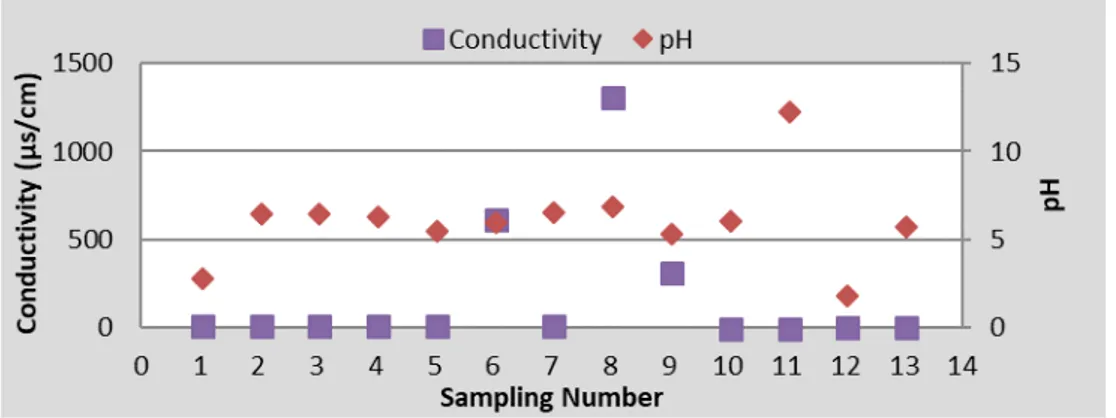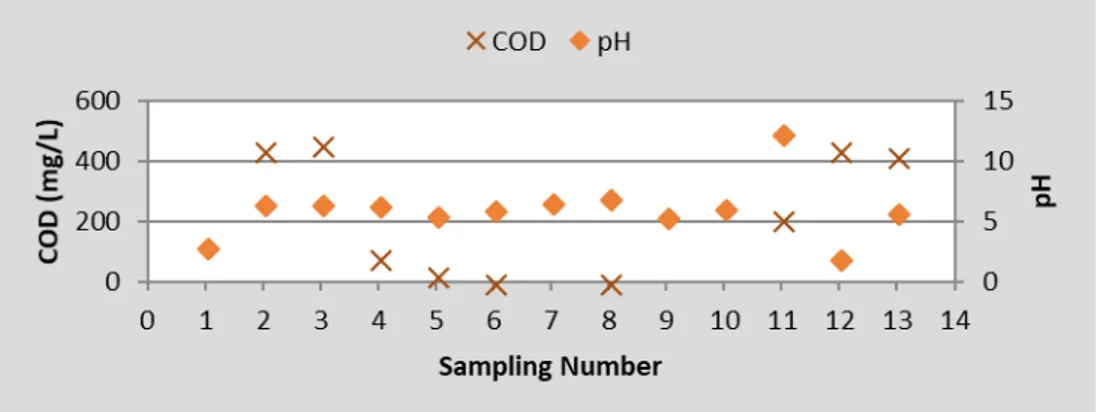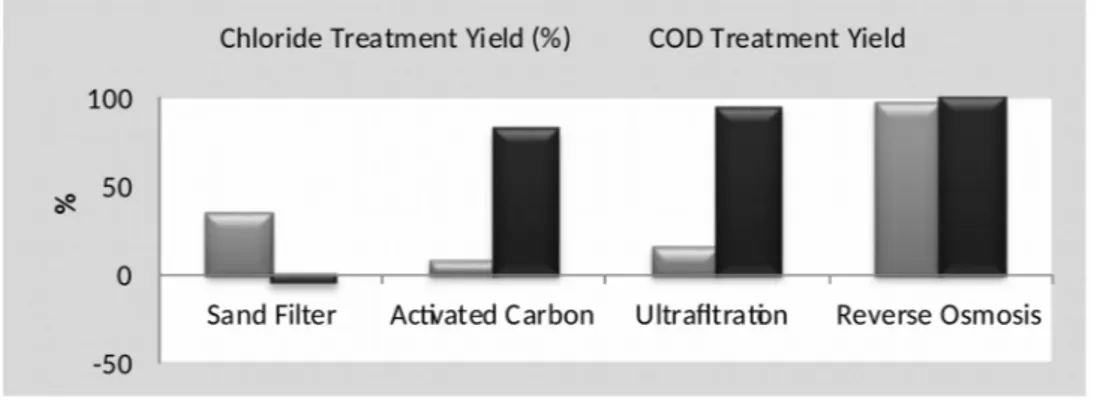Examination and Evaluation of a Metal Industry Wastewater Treatment and Recycle
S. Güneş Durak*
*Faculty of Architecture and Engineering, Department of Environmental Engineering, Nevsehir Haci Bektas Veli University, Nevsehir, Turkey.
(Corresponding Author’s E-mail: sgdurak@nevsehir.edu.tr) ABSTRACT
Discharge of industrial wastewater into the environment without being subjected to proper treatment results in both reduction of resources and damage to the environment and destruction of biological diversity. In addition, treatment and reuse of industrial wastewater as a measure to consume clean water resources will reduce water consumption and at the same time remove oil, grease, alkali, acids and toxic substances from wastewater and discharge the wastewater to the environment will prevent contamination of water resources. In addition, recovery and reuse of waste water is an advantage. As is known, leaving the industrial wastewater to the environment without treatment causes some problems in the biological environment. For example, wastewater containing harmful chemicals damages living organisms in the aquatic environment and living organisms in the ground. Accordingly, in sand filtration, active carbons, ultrafiltration, and reverse osmosis units, chloride and COD removal efficiencies are compared to the water quality in the main promoting pipe.
Keywords: COD, Ultrafiltration, Wastewater treatment.
INTRODUCTION
Nowadays, the freshwater resources, which are very low due to rapid population growth and excessive unconscious use, are gradually decreasing. Cause of drinking water using in industries, the reduction of water resources has a great deal. According to the researches carried out, the main activities that cause firstly irrigation and secondly water consumption are industrial activities. Therefore, measures such as the treatment and reuse of wastewater used to reduce the use of freshwater resources in the industry have recently come to the forefront. Reduction of freshwater resources will also be avoided by reusing wastewater. Metal plating industry is one of them.
Plating is the application of a plate, or coat, of metal to surface for decoration, protection against corrosion or increased wearing quality. The surface of metal productions contains oils or greases. They are removed by warm alkali (degreasing). Due to the alkali used to clean them and plating methods, metal industry wastewater has high pH, suspended solids, metal particles, soaps, nitride, sulfide, chloride, grease, and oil etc. After degreasing, the materials are sent to the stationary baths. The rinse and washing effluents are usually alkaline. Plating baths are acidic and contain sulfuric acid, hydrochloric acid or nitric acid. In alkaline baths, carbonate, hydroxide, and cyanide are used. After plating, the materials are sent to the rinsing unit behind the stationary baths. The solution in the stationary baths cannot be discharged as wastewater because they contain contaminants above the specified limits. However, the rinsing water can be discharged to receiver environment. The solids in the wastewater that are
released from the stationary baths are not high volume but may contain significant toxic chemical substances (Ranade and Bhamdari, 2014). Due to the discharge of large amounts of metal-contaminated wastewater, industries bearing heavy metals, such as chromium, zinc, copper, nickel, tin, and cyanides, are the most hazardous among the chemical-intensive industries (Barakat, 2011).
These pollutants are adversely affected by the environment and public health when the wastewater is directly discharged. For this reason, the wastewater should be treated to the required limits and discharged to the environment after the necessary standards are met. Metal precipitation, flocculation, sedimentation and discharge techniques are used for the treatment of metal plating wastewater. Implementation of such techniques can be time-consuming and requires extensive installation. At each step, a sedimentation tank must be provided and constant pH control is required to determine the amount of acid, coagulation, lime or caustic and polymeric flocculants. In addition, up to $50,000 is required to carry out these treatment activities for a year (Amer, 1998).
In this study, treatment of a metal industry wastewater by different methods, treatment yield of chloride and COD, and reusing of treated water is examined. However, it has been determined that the chlorine present in the wastewater cannot be completely removed by the existing units. Alternatives have been researched to provide complete treatment.
MATERIALS AND METHODS Metal Production
The metal industry wastewater consists of metal working, metal plating, and washing plants parts. Here, impure metals are prepared, purified and converted into appropriate products. The metal hardens after a certain period of time. It is not cooled before giving shape. After hardened, it must be immersed in the acid bath to remove oxides and rusts. The acid is used for this process 5-10% H2SO4. The metal is washed and then subjected to a metal plating
process after the acid is left. After the plating process, the metal is washed again. Subsequently, it is submerged to acid in order to polish and washed again and sent to the oven to be dried (Şengül, 1991).
Characterization of Metal Industry Wastewater
Metal industry sector are mainly based on iron and steel processing facilities, metal preparation and processing, galvanizing, etching, electrolytic plating, metal coloring, zinc plating, quenching and hardening, conductive plate manufacturing, battery manufacturing, enameling, lacquering and varnishing facilities, lining-painting, non-ferrous metal production, aluminum oxide and aluminum smelting, iron and non-ferrous foundry and metal forming. As a result of these activities, metal industry wastewaters contain acid, alkali, oil, metal and sometimes trace amounts of toxic substances (WPCR). Therefore, treatment methods for these pollutants must be identified in the treatment of metal industry wastewater.
The characteristics of the wastewaters of metal industrial wastewaters, which are generally opened to the metal preparation and processing activities, are given in Table 1 (WPRC).
Figure 1. Metal plating stages.
Table 1. Metal Industry (Metal preparation and processing)
Parameter Units Composite Sample 2 hours Composite Sample 24 hours
Chemical Oxygen Demand (COD) (mg/L) 200 100
Mixed Liquid Suspended Solids (MLSS) (mg/L) 120 50
Oil and Grease (mg/L) 20 10
Ammonium (NH4-N) (mg/L) 100 -Nitrite (NO2-N) (mg/L) 10 5 Active Chloride (mg/L) 0.5 -Sulfide (S‾2) (mg/L) 2 -Total Chrome* (mg/L) 2 1 Chrome (Cr+6) * (mg/L) 0.5 0.5 Lead (Pb)* (mg/L) 2 1 Total Cyanide (CNˉ)* (mg/L) 0.5 0.1 Mercury (Hg)* (mg/L) 0.05 0.01 Cadmium (Cd)* (mg/L) 0.5 0.1 Aluminum (Al)* (mg/L) 3 2 Iron (Fe)* (mg/L) 3 -Fluoride (Fˉ)* (mg/L) 50 30 Copper (Cu)* (mg/L) 3 1 Nickel (Ni)* (mg/L) 3 2 Zinc (Zn)* (mg/L) 5 3 Silver (Ag)* (mg/L) 0.1 -pH - 6-9 6-9 Wastewater
Wastewater containing oil and grease must be passed through an oil unit and then chemically treated. As the oil and grease materials separate from the wastewater, the amount of BOD decreases due to organic matter removal. Accordingly, biodegradation of pollutants accelerates.
Recovery from these wastewaters is carried out by membrane processes such as reverse osmosis, ion exchange, evaporation, chemical precipitation, filtration, electrochemical processes.
Overview of Wastewater Treatment Plant
Wastewater treatment plant includes main promoting pipe, balancing tank, neutralization tank, coagulation-flocculation unit, precipitation tank, sludge tank, filter press, sand filtration unit, activated carbon unit, ultrafiltration and reverse osmosis units (Fig. 2).
Main promoting pipe: After metal production process, wastewater sends to main promoting tank for collecting. Then it is moved to balancing tank.
Balancing tank: In the balancing tank unit, mixing is carried out in order to stabilize the concentration and prevent sedimentation. In addition, partial oxidation occurs of the materials which can be oxidized and BOD by mixing and aeration.
Neutralization: The neutralization unit is the process of adjusting the pH of industrial wastewaters of acidic and basic character. Adjustment of the wastewater pH is necessary to ensure the acceptance of waste water by the acceptance discharge standards, to ensure the proper pH value before the biological treatment, and to ensure the appropriate pH value for the chemical precipitation reaction.
Coagulation-Flocculation: Coagulation can be briefly described as the process of collapsing solid particles (10-3 -1 μm) in colloid size, which cannot sediment with their own weights, with various chemistries. The second step of this process is the flocculation process provided by the collapsing of the growing particles.
Precipitation: Precipitation is carried out in order to remove the suspended solids in the water. It is applied to eliminate many flocs with color and turbidity.
Sludge Tank: The sludge at the base of the sediment is conveyed to the sludge tank with pumps.
Filter Press: Filter press provides dewatering of the sludge under high pressure. At the outlet, a sludge cake that solid content is high is obtained.
Sand Filtration: It is applied in order to contain suspended solids and colloids which cannot be removed sufficiently in the treatment process. The substances are trapped by the passage of water through the granular filter bed. Backwashing is performed to remove the solid substances that accumulate in the filter bed.
Activated Carbon Unit: It is applied for the collection of water-soluble substances at a convenient interface. In order to obtain a water of the required quality, the active carbon should be provided at the outlet of the treatment plant.
Carbon adsorption is used to remove refractory organic compounds and residual compounds of inorganic materials such as nitrogen, sulfate, and chloride. In the reuse of treated water, it is advantageous to remove the odor and taste components (Metcalf & Eddy, 2004).
Ultrafiltration: Semi-permeable membranes are applied to wastewater by pressurized membrane filtration. The wastewater containing the macromolecule and the colloid substance is purified.
Reverse Osmosis: It is generally used in the treatment of industrial wastewater. Reverse osmosis is used in order to reuse wastewater, to the removal of dissolved inorganic and organic substances from wastewater. The water from the reverse osmosis is recovered by recirculating.
Acidic continuous rinse waters from industrial sources are taken from two separate lines, oil taking bath and dying wastewater. The rinse water from the acid baths is collected in a balancing tank with a volume of 30 m3 and is automatically taken to chemical treatment with
the help of an air pump. Concentrated acidic wastewater is taken into a balancing tank with a volume of 30 m3 and given to the continuous treatment slowly. Boron oil wastewater is taken
to the reaction tank. In the reaction tank, the emulsion breaking process is applied to remove the dissolved oil in the wastewater. With the aid of acid to be added to the reaction tank, it is possible to disintegrate the dissolved oil in the wastewater and collect it on the tank. For this purpose, firstly the pH value of the wastewater is adjusted by acid dosage as 1.5-2. After the waiting period, the upper layer of oil layer is raised by the water level of the tank or is poured into the pumping tank. The oil that accumulates here is pumped to the phase separation tank by means of a pump in order to reduce the water content that may accumulate therein. In the phase separation tank, the water in the lower phase is fed to the reaction tank at the end of the waiting period and the oil in the upper phase is transferred to the waste oil barrel. The wastewater separated from the oil in the reaction tank is also treated by chemical precipitation in this tank. Dosing operations are performed manually in this phase. The sludge accumulating in the bottom of the tank is taken to a steel mud deposit with a pump, and the de-oiled wastewater that accumulates on the surface is slowly pumped through a dosing pump.
Ultrafiltration and reverse osmosis units are never operated on days when oil treatment is available.
In the coagulation tank, which is the first unit of continuous chemical treatment, caustic (NaOH) is dosed and the pH is raised to above 10.5 and nitrate (NO3) is oxidized by oxidizing
nitrite (NO2) present in the wastewater by dosing sodium hypochlorite (NaClO) to the same
tank. The wastewater which is raised in pH is taken to the neutralization tank with its own attraction and neutralized by reducing the pH to 8-8.5 by carrying out the coagulation process with Iron III Chloride (FeCl3) chemistry and acid dosing. Then the wastewater will be taken to
the flocculation unit with its own attractiveness and will be subjected to flocculation process by giving polyelectrolyte automatically. As the wastewater exits the flocculation tank and the surface load is increased to the cylindrical type laminated sedimentation tank, the flocculation in the wastewater is collapsed. The wastewater is then passed through the sand and activated carbon filter and reduced to below the discharge criteria.
However, the use of this treated water for reprocessing is decided as the result of the analysis at the facility exit.
If boron oil is not removed from the treatment system, the treated water has a COD value of about <500 mg/L and after passing through activated carbon columns, the COD value again falls below about 250 mg/L. Under these conditions, it is thought that it will be more convenient to use in the production of treated water.
The water from the filter columns is taken from the ultrafiltration unit feed tank. The water in the supply tank is passed through ultrafiltration modules with the aid of the pump. The water passing through the ultrafiltration modules is taken to the reverse osmosis unit feed tank. The water withdrawn by a hydrophore from the reverse osmosis feed tank is passed through the modules by increasing the pressure with the high-pressure pump. Through the semi-permeable natural structure of the membrane, the passage of water is easier than the passage of dissolved minerals. Water in less dense solution wants to dilute more concentrated solution. The concentration difference between the two solutions arises and determines the osmotic pressure differential. When the pressure is applied to the concentration of osmotic pressure which is large, the passage of water is reversed and reverse osmosis is established.
The feed current is provided with a 30-60% protection of the volume. The most important parameter in the water to be treated by reverse osmosis is the TDS value. TDS is a parameter proportional to conductivity. The conductivity of water passing through reverse osmosis unit is reduced by 98-99% and sent to the pure water tank.
It is estimated that active carbon used at the exit of the treatment plant will also be in use for about 4-6 months.
The chemical sludge that accumulates in the bottom of the sedimentation pool is taken into the steel sludge deposit of the currently used treatment plant with the help of a pump. With the filling of the sludge accumulation tank, the air filter diaphragm filter press feed pump is activated and the existing filter press sludge is pumped. Filter press filtrate waters are taken to one of the concentrating balancing pools with their own attraction.
RESULTS AND DISCUSSION
In this study, the facility where the wastewater is treated and the metal recovery is carried out is made up of the balancing tank (1), main promotion pipe (2), sand filter (3), activated carbon (4), ultrafiltration (5), reverse osmosis (6), neutralization tank (7), well water (8), passivation rinse (9), zinc rinse (10), hot lubrication (11), acidic lubrication (12), total organic waste (13) units and for these waters pH, conductivity (μS/cm), chloride (mg/L) and COD (mg/L) values were analyzed. The results are given in Table 2. When the table is examined it is determined that there is a problem in the removal of chloride and that even in the reverse osmosis unit providing the most COD removal, complete removal is not achieved for chloride.
Figure 3. pH and conductivity values.
Fig. 3 shows the pH and conductivity values. The pH value is measured in the hot lubrication unit the highest and in the acidic lubrication unit the lowest. Conductivity is much higher than the average in well water. Then the reverse osmosis effluent was determined to be the highest conductivity.
The lowest conductivity was determined in hot lubrication and zinc rinse units. It is not possible to say that there is a significant correlation between the pH and conductivity even though highest pH value indicated in the same unit that has the lowest conductivity.
Table 2. Analyze results.
Sample pH Conductivity(µs/cm) Chloride (mg/L) COD(mg/L)
1 (Balancing tank) 2.91 21.2 9900
2 (Main promoting pipe) 6.57 24.7 9700 438.26
3 (Sand filter) 6.6 23.4 6340 459.13 4 (Activated carbon) 6.46 22.9 9000 78.84 5 (Ultrafiltration) 5.65 22.3 8220 <25 6 (Reverse osmosis) 6.13 626 280 0 7 (Neutralization tank) 6.7 25.4 7400 8 (Well water) 7.05 1325 220 0 9 (Passivation rinse) 5.5 327 360 10 (Zinc rinse) 6.21 9.11 2600 11 (Hot lubrication) 12.42 8.18 600 208.69 12 (Acidic lubrication) 1.98 17.57 2500 438.26
Fig. 4, compared to pH and chloride values, generally in acidic pH values, chloride value was measured higher. Chloride has lower values in alkaline units.
pH and COD values were given in Fig. 5. When these two parameters are compared, the lowest COD value is determined in the hot lubrication unit where the highest pH is detected, although there is no significant correlation between them. Also, Fig. 6 shows that the chemical oxygen demand is higher in the acidic units.
Figure 4. pH and chloride values.
In Fig. 6, there is a comparison between main promoting pipe and sand filter, activated carbon, ultrafiltration and reverse osmosis units. According to the results, in the sand filter unit, chloride treatment yield was obtained %35, COD treatment yield was obtained %-5. So, there was not a COD treatment in sand unit, on the contrary, COD increasing occurred. In activated carbon unit, treatment yield was determined %7 for chloride and %82 for COD. In ultrafiltration unit, treatment yield was defined %15 for chloride and %94 for COD. Finally, for reverse osmosis unit, chloride treatment yield was %97 and COD treatment yield was %100. To base on these results, within these units, reverse osmosis provides the highest treatment for chloride and COD. Studies have shown that the tight and least permeable reverse osmosis unit rejects monovalent single charged ions such as sodium (Na+) and
chloride (Cl-) (Judd et al., 2008). The reverse osmosis unit provides a highly efficient
treatment for chloride. The sand filter is an only physical treatment method, so it is not too effective, compared to other treatment methods (Fig. 6).
Figure 5. pH and COD values.
Wastewater that comes to the metal plating wastewater treatment unit, has a high concentration of chloride. Chloride can be converted advantageously and reused again. It is
advised that an electrodialysis unit can be placed immediately in front of the reverse osmosis unit to recover the chloride ion. A simple electrodialysis system comprises ion exchange membranes placed in a mold between an anode and a cathode. A solution which is more concentrated in terms of the cation and anion desired to be separated is obtained at the end of the electrodialysis process. In this way, while the ions to be recovered (especially the ions of precious metals) are separated in a more concentrated state, the purification of the feed solution is also carried out (URL, Ergün, 2008). Chloride obtained by electrodialysis can be recovered as HCl and used again in production stages. The wastewater that passes through the reverse osmosis unit will have a more favorable form of re-use because the chloride content in the wastewater sent to the reverse osmosis unit after being passed through the electrode unit is reduced. In this way, both the chloride ions will be recovered and reused, and the already limited water resources will not be consumed by reuse in the treated wastewater system, which provides high-efficiency treatment and reuse standards.
Figure 6. Treatment yield values for different treatment units. CONCLUSIONS
In this study, a metal industry was selected and, its wastewater treatment and recovery were examined. In analyzes, pH, conductivity, chloride and COD values evaluated as influent and effluent for different units. According to the results, a similar relation can be mentioned between pH and KOI values. But other parameters did not show a significant relation.
In addition, the treatment process for chloride and COD, reverse osmosis provides the highest treatment yield. It is an expensive method but it is too effective for wastewater treatment. However, the reverse osmosis unit in the system has not been a complete solution to the chloride problem.
It will be appropriate to place the electrodialysis unit before the reverse osmosis unit to provide complete removal of chloride. In addition, according to the results, the chloride purifying half-value, the chloride purifying ability of the activated carbon unit, to be able to solve the chloride problem should often be evaluated by the chloride removal half-value test (German Standard DIN 19603).
Amer S.I. 1998 Treating Metal Finishing Wastewater, Aquachem Inc. Environmental Technology. Missouri City, TX. http://aquacheminc.com/Treating%20Metal %20Finishing%20Wastewater.pdf (accessed 14 March 2017)
Barakat, M. A. 2011. New trends in removing heavy metals from industrial wastewater.
Arabian Journal of Chemistry, 4(4), 361–377.
https://doi.org/10.1016/j.arabjc.2010.07.019
DIN 19603. Standard Methods for Activated Charcoal for Water Treatment. 1969. Technical Conditions of Delivery, Germany.
Ergün E. 2008 Removal of Fluoride by Electrodialysis Method. Master thesis, Department of Environmental Engineering, Konya, Turkey.
Judd S., Kim B.G. & Amy G. 2008 Membrane Bioreactors, Biological Wastewater Treatment, Principles, Modelling and Design, IWA Publishing.
Metcalf & Eddy. 2004 4th Edition. Wastewater Engineering Treatment and Reuse, International Edition, 1149.
Ranade V.V. & Bhandari V.M. 2014 Industrial Wastewater Treatment, Recycling and Reuse, books.google.com (accessed 28 March 2017)
Şengül F. 1991 2nd Ed. Industrial Wastewater and Treatment, D.E.U. Engineering Faculty, İzmir, Turkey.
Water Pollution Control Regulation of Turkey, Official Gazette Date: 31 December 2004, Official Gazette Number: 25687.
